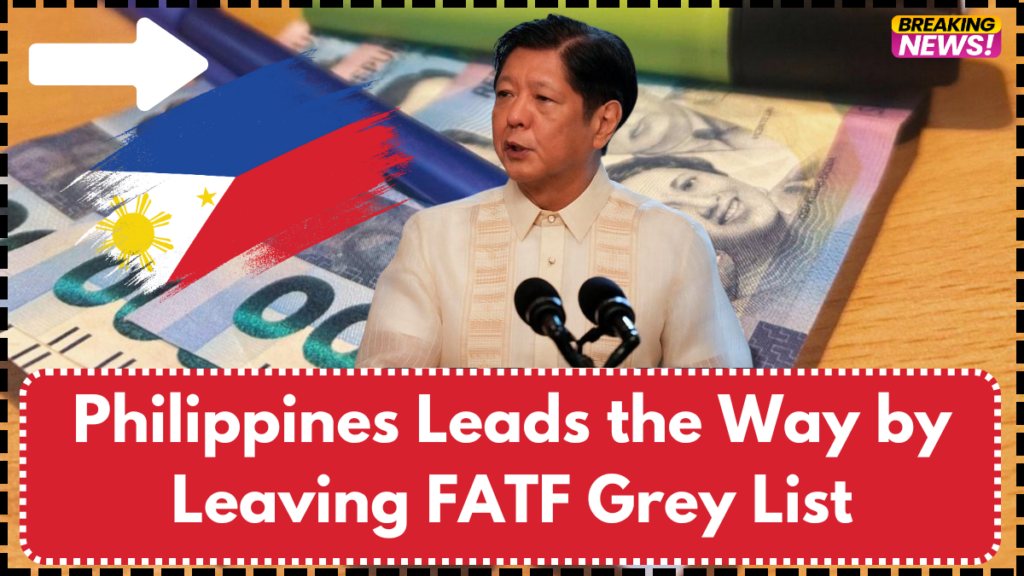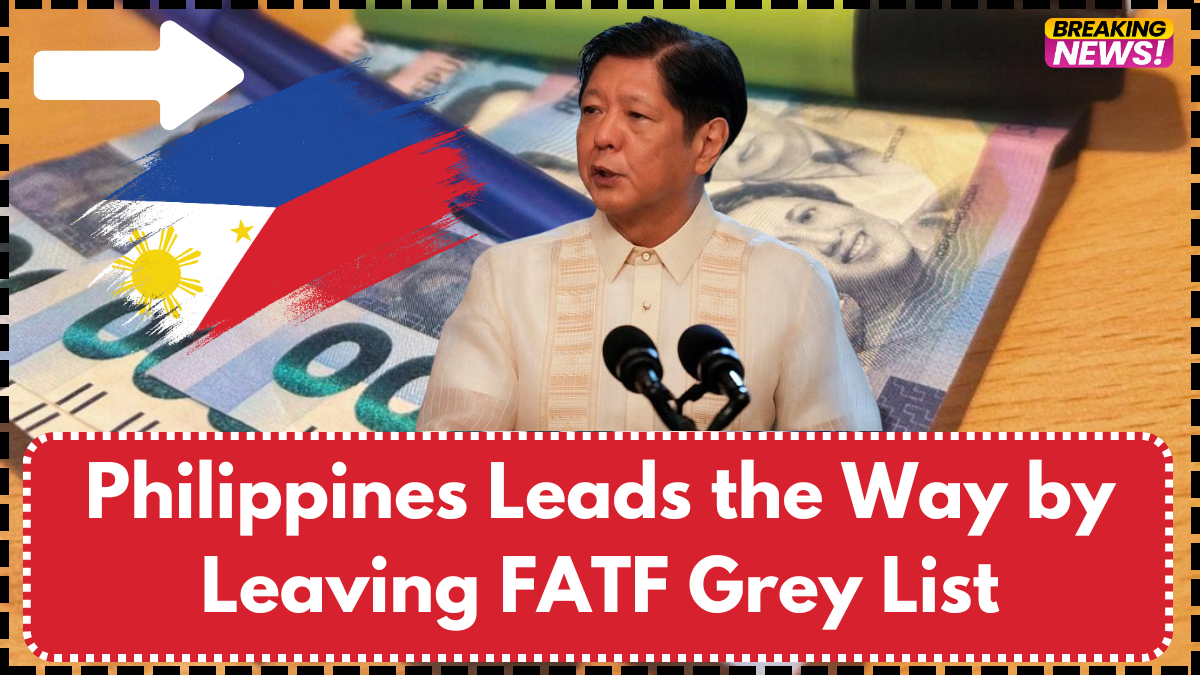The Philippines has successfully exited the Financial Action Task Force (FATF) grey list, marking a significant achievement in global financial governance. This milestone follows four years of extensive reforms aimed at strengthening the country’s framework against money laundering and terrorist financing. Meanwhile, Laos and Nepal have been newly added to the FATF grey list, signifying the need for enhanced financial oversight in these nations.
The removal of the Philippines from the grey list reflects international confidence in its improved anti-money laundering (AML) and counter-terrorist financing (CTF) measures. It highlights the country’s dedication to aligning its financial regulations with global standards and ensuring robust financial transparency.

Key Reforms That Led to the Philippines’ Removal
The FATF recognized the Philippines’ substantial progress, particularly in legislative amendments and enforcement mechanisms. Some of the critical reforms included:
- Strengthening the Anti-Money Laundering Act – Updates to existing laws to tighten financial controls and improve compliance.
- Enhanced National Risk Assessments – A more effective framework for identifying and mitigating financial crime risks.
- On-Site Evaluations – The FATF conducted a thorough assessment, confirming that the measures were being effectively implemented.
These initiatives have contributed to an improved financial reputation for the country, paving the way for better trade opportunities and increased foreign investments.
Economic and Financial Benefits for the Philippines
The removal from the grey list is expected to have significant economic benefits. According to Finance Secretary Ralph G. Recto, this achievement strengthens public confidence in the country’s financial system. Additionally, it may lead to a possible credit rating upgrade, which could attract more investors.
The Anti-Money Laundering Council (AMLC) also emphasized the practical benefits of this removal, including:
- Lower compliance barriers – Businesses will face fewer regulatory hurdles in international transactions.
- Improved cross-border transactions – Overseas Filipino Workers (OFWs) may experience faster and cheaper remittance processing.
- Enhanced trade and investment – A more favorable financial standing can encourage greater foreign direct investment (FDI).
Laos and Nepal Added to FATF Grey List
While the Philippines has made notable progress, Laos and Nepal have been newly placed on the FATF grey list due to deficiencies in their financial oversight systems. Being on the grey list means these countries require increased monitoring to address shortcomings in their AML and CTF frameworks.
Challenges Facing Laos
Laos has struggled with financial supervision, leading to its grey listing. Key issues identified by the FATF include:
- Weak regulatory oversight – Insufficient controls over financial institutions and transactions.
- High-risk sectors underregulated – Inadequate monitoring of casinos and Special Economic Zones (SEZs).
- Limited financial intelligence sharing – Poor coordination among financial agencies to combat money laundering.
- Weak enforcement actions – Ineffective prosecution and penalties for financial crimes.
The consequences of remaining on the grey list include increased scrutiny from international financial institutions, potential disruptions to foreign investments, and challenges in maintaining stable banking relations. To exit the grey list, Laos must collaborate with the FATF to strengthen its financial regulations and enforcement capabilities.
Nepal’s Regulatory Shortcomings
Similar to Laos, Nepal’s grey listing is linked to structural and policy deficiencies in its AML and CTF measures. The Asia/Pacific Group on Money Laundering (APG) found the following weaknesses:
- Limited enforcement of financial laws – Inconsistent prosecution of money laundering and financial crimes.
- Regulatory gaps in high-risk sectors – Inadequate oversight of cooperatives and real estate transactions.
- Incomplete policy reforms – Delays in implementing necessary financial legislation.
Nepal must develop and implement an action plan within a specified timeframe, typically subject to quarterly reviews. If progress is rapid, the country may have the opportunity to exit the grey list within a year. However, failure to comply could result in prolonged financial scrutiny and economic repercussions.
Implications and Future Outlook
The FATF grey list serves as an international benchmark for evaluating a country’s commitment to preventing financial crimes. Placement on this list signals heightened scrutiny from global financial institutions, which can lead to increased compliance costs, reduced foreign investment, and slower economic growth.
For the Philippines, the removal from the grey list is expected to:
- Boost investor confidence – A stronger financial reputation can lead to more trade partnerships and investment opportunities.
- Facilitate smoother transactions – Businesses and financial institutions will benefit from fewer regulatory obstacles.
- Reduce remittance costs for OFWs – Lower financial transaction fees will provide economic relief to millions of Filipinos working abroad.
On the other hand, Laos and Nepal must prioritize addressing their regulatory deficiencies. Their governments must:
- Implement stricter financial oversight policies.
- Enhance enforcement mechanisms for prosecuting financial crimes.
- Strengthen international cooperation to combat money laundering and terrorist financing.
By making these necessary reforms, Laos and Nepal can work towards exiting the grey list and securing a more stable and attractive economic environment.
Summary of FATF Grey List Changes
| Country | Status | Key Issues | Expected Outcomes |
|---|---|---|---|
| Philippines | Removed from Grey List | Strengthened AML laws, enhanced risk assessments | Increased foreign investments, lower remittance fees, improved credit rating potential |
| Laos | Added to Grey List | Weak regulatory oversight, poor enforcement, high-risk sectors unmonitored | Higher compliance scrutiny, potential investment decline |
| Nepal | Added to Grey List | Limited enforcement, regulatory gaps in cooperatives and real estate | Required to implement action plan for possible removal within a year |
Final Thoughts
The removal of the Philippines from the FATF grey list is a testament to its dedication to financial integrity and international cooperation. Moving forward, maintaining these reforms will be crucial to sustaining investor confidence and economic stability.
Meanwhile, Laos and Nepal must take decisive action to address their financial oversight weaknesses. Through robust policy reforms and improved enforcement mechanisms, they can enhance their financial credibility and work toward removal from the grey list. These developments underscore the importance of global financial compliance in fostering economic resilience and stability.
Frequently Asked Questions
What does it mean for a country to be on the FATF grey list?
A country placed on the FATF grey list is subject to increased monitoring due to deficiencies in its anti-money laundering and counter-terrorist financing measures. It must work with the FATF to resolve these issues within a specified timeframe.
How did the Philippines manage to exit the grey list?
The Philippines implemented several key reforms, including amendments to its Anti-Money Laundering Act, enhanced risk assessments, and improved financial enforcement mechanisms. A successful on-site evaluation by the FATF confirmed the effectiveness of these measures.
What are the consequences of being on the grey list?
Countries on the grey list face greater scrutiny from international financial institutions, leading to potential economic drawbacks such as reduced foreign investments, increased compliance costs, and difficulties in banking relations.
What steps must Laos and Nepal take to exit the grey list?
Both countries need to implement stricter financial regulations, enhance enforcement of financial crimes, and strengthen international collaboration in combating money laundering and terrorist financing.
How long does it take for a country to be removed from the grey list?
The timeframe varies, but countries must meet FATF requirements and demonstrate effective implementation of reforms. The process typically involves quarterly reviews, and removal can take a year or more, depending on the speed of compliance.
These developments underscore the critical role of global financial compliance in fostering economic stability and international confidence.
Click here to learn more
Pari is a passionate writer known for captivating stories that blend imagination and reality. Inspired by travel, history, and everyday moments, Pari crafts narratives that resonate deeply with readers.
